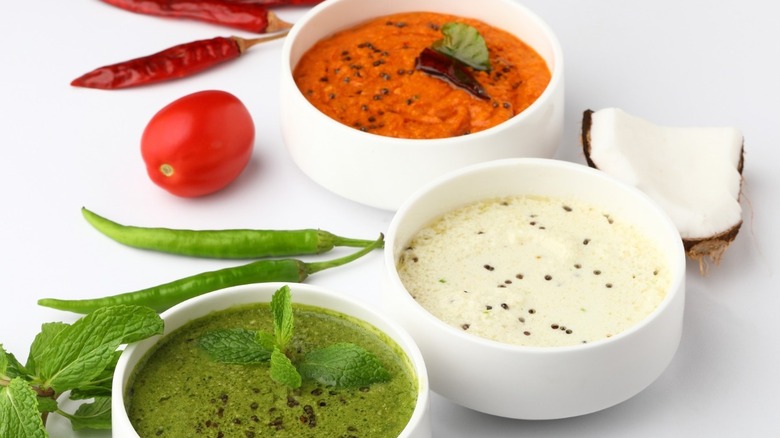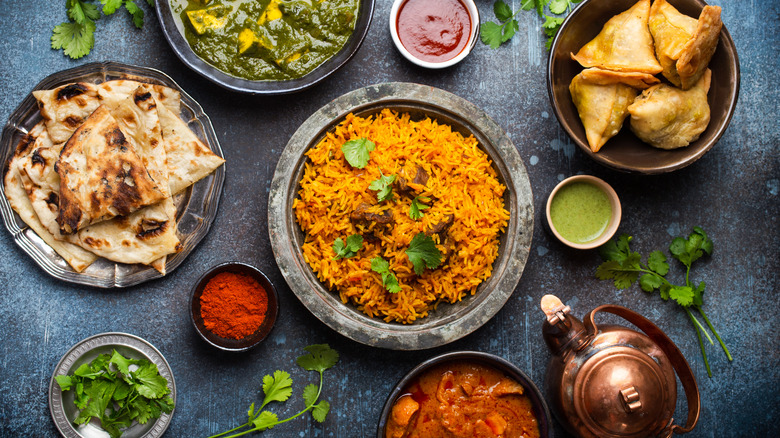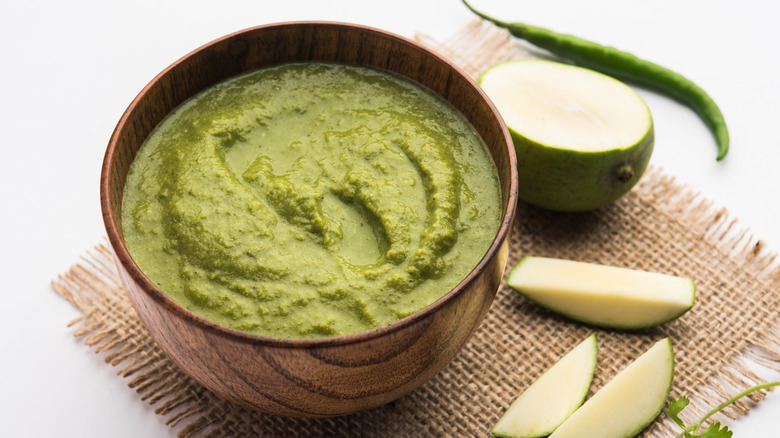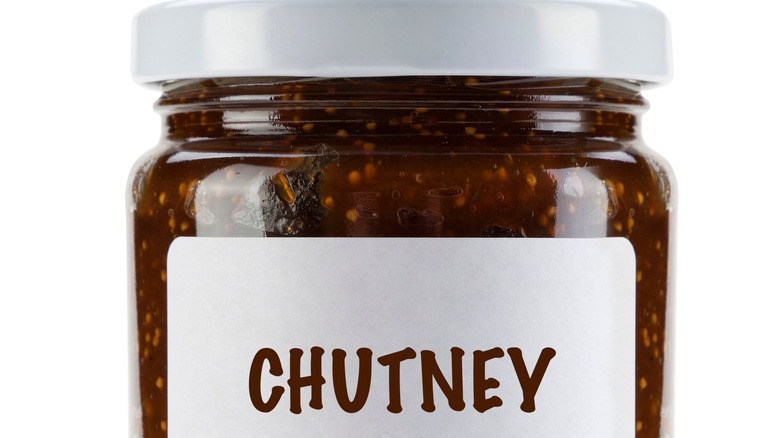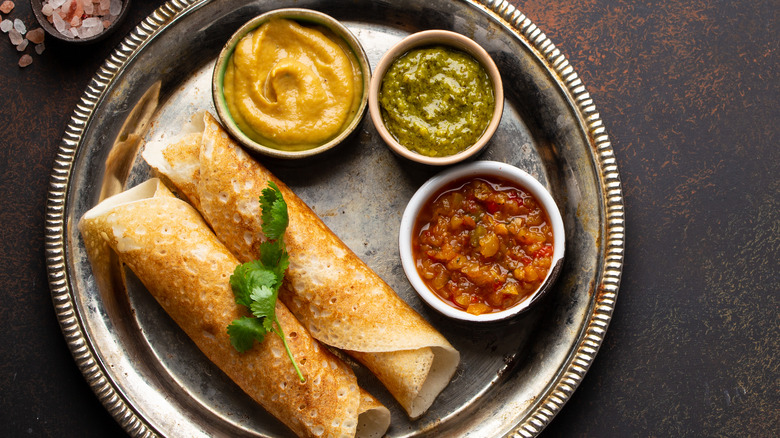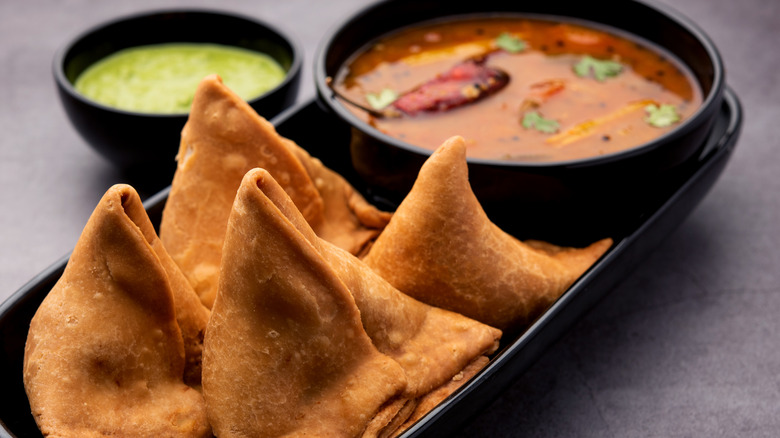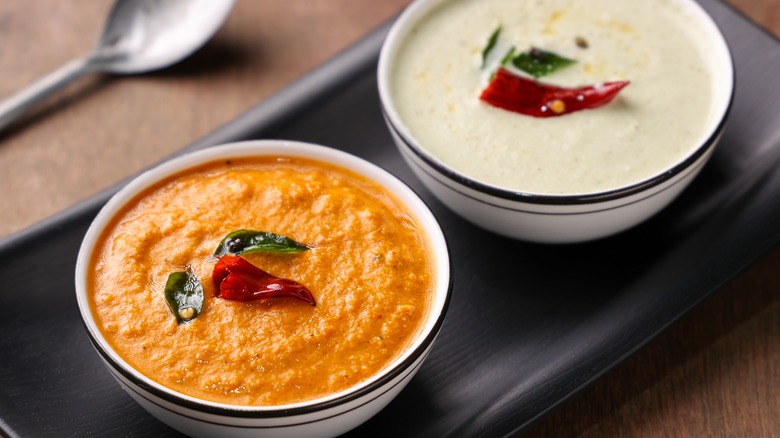What Is Chutney And Is It Spicy?
America has jam and jelly, not to mention ketchup, mustard, mayonnaise, and relish. Japan has miso, a reddish-brown paste made with fermented soybeans, that gives a pop of salty and savory flavor to many foods. Thailand has sriracha, a fiery red chili sauce that originated in the coastal town of Si Racha and is now largely made in America (per The Economic Times).
India has chutney, and it is arguably the king of condiments across the land. Just as each state, or region, has its own language and culture, each state has its own chutney or chutneys – and some of them are hot stuff (per The Washington Post). It might sit at the side of the plate, off-stage from the main course, but chutney plays a prominent role in Indian cuisine. It is served with just about every meal.
Chutney is a sidekick to curry dishes and can be used to add flavor to otherwise ordinary food, like rice. It's also used as a bread spread, as in the Bombay sandwich, one of the most popular and widely available street foods in Mumbai. It's a melange of cooked and fresh vegetables, built on a foundation of bread and chutney.
What is chutney?
What, exactly, is chutney? At its most basic, chutney is a relish-like condiment made with fruit, vegetables, or both – plus spices, according to Food Reference. The texture ranges from smooth to chunky, and the flavor profile ranges considerably, including mild, sweet, and downright hot versions. Some chutneys are made with fresh ingredients, while other chutneys are cooked.
It seems fair to say that chutney is different things to different people in different places. Is it a jam? Or a marmalade? Or a preserve? Some consider chutney, especially when sugar is added and it's cooked, to be a type of jam – a savory jam with spices and vinegar added, but no pectin to firm it up (per Eater).
What ingredients are in chutney? A more reasonable question might be what ingredients aren't in chutney? There are so many variations. Common ingredients, per Food Reference, include onion, apple, mango, pear, tamarind, tomato, raisins, garlic, mint, coconut, chilies, coriander, cinnamon, cardamom, ginger, and turmeric.
Is chutney spicy?
According to Etymonline, the word chutney is derived from "chatni," an East Indian word that reportedly means "strongly spiced.” But not all chutney packs heat or is loaded with spices.
In a piece for South China Morning Post, India-based writer and educator Ranjini Rao explained that coconut chutney reigns supreme in southern India, while hari chutney – a green sauce made with coriander, mint, and green chilies – is commonplace in the north. In Maharashtra, in the west of India, garlic chutney infused with red chili peppers wakes up food and taste buds. Fruit chutneys seasoned with spices are sometimes served as dessert in West Bengal, in the east of India. Tamarind chutney, often served at Indian restaurants, has sweet, sour, and tangy notes (per Serious Eats).
The most widely known and available chutney is Major Grey's, which is a style of mango chutney, not a brand. Its origins are said to date to the 1800s, and it is believed to have been developed by a British military officer who spent time in India, according to "The Routledge History of Food."
Major Grey's chutney is neither spicy nor hot. Crosse & Blackwell, which bills itself as the top chutney seller in the U.S., describes its version of Major Grey's as "tart and engaging.” The first ingredient listed on the product label is sugar, followed by mangoes, vinegar, salt, raisins, lime juice concentrate, tamarind juice concentrate, spices, onion powder, and natural flavor.
How is chutney made?
Chutney might be ubiquitous in India, but there is no universal way to make it. Fresh chutneys, for example, can be made in a mortar and pestle or whirred together quickly in a food processor (per Serious Eats). Ranjini Rao, a writer and communications professor in Bangalore, India, recalls her grandmother "hunched over the grinding stone, known locally as oralu kallu, throwing in all manner of shallow-fried lentils, coconut, tamarind pulp, and other ingredients, depending on the meal of the day and the mood, grinding it all into a sizeable mass of chutney” (per South China Morning Post).
Cooked chutneys can be made in a saucepan, skillet, Dutch oven, or pressure cooker (per MasterClass). If you have apples, mangoes, spices like cinnamon and cardamom, and an Instant Pot, you can make Apple Mango Chutney (via AllRecipes). Cooked chutney can be canned, but it is essential that vinegar be added to do so safely (per PennState Extension). Depending on the vegetable content, some chutneys might require pressure canning. The National Center for Home Food Preservation has guidelines and tested recipes.
Where to find chutney
In the United States, chutney is available pretty much everywhere we buy groceries, from supermarkets like Whole Foods and Trader Joe's to big-box stores like Walmart to small, independently owned, ethnic markets and gourmet shops (per Thrive Cuisine). At the grocery store, chutney might be stocked in the condiments aisle or the international foods section.
Commonly available brands of chutney include Swad, Patak's, and Crosse & Blackwell. The best-selling chutneys on Amazon include Crosse & Blackwell Major Grey's chutney, Mrs. Ball's hot chutney (from South Africa), and Stonewall Kitchen mango chutney.
Specialty food companies like Wild Thymes Farm, New England Cranberry Company, and the Virginia Chutney Company offer many creative takes on chutney. Neera's Chutneys, by the Cinnabar Specialty Foods Company, take their name from Neera Tandon, a native of India. The line includes flavors like pear cardamom, ginger pineapple, and tomato mint chutney.
How to cook with chutney
If you pick up a jar of chutney for yourself or receive one as a gift, there are many things you can do with it. A good place to begin is to stir some chutney into rice for a quick kick of flavor (via BBC GoodFood). Indian food writer and cookbook author Monica Bhide likes to make savory mini phyllo shell "cheesecakes" to spotlight spicy Red Pepper and Green Tomatillo Chutney (per National Public Radio). "This dish is always a smash hit at parties and is super-easy to make,” she said.
Speaking of parties, chutney and cream cheese make for easy appetizers. Layer chutney on top of a brick of cream cheese and serve with crackers. Or, combine softened cream cheese and chutney in a food processor to create a spread for crackers or bread. Give ordinary meat and vegetable sandwiches an upgrade by mixing equal parts mayonnaise and chutney and spreading the mixture on the bread of your choice. Likewise, use chutney to take basics like grilled cheese or cheese and crackers in a new and flavorful direction.
Nutritional info about chutney
Different chutneys contain varying amounts of vitamins, minerals, antioxidants, and other nutritional benefits, depending on the ingredients (per News18). That includes coconut chutney. Coconuts contain healthy fats and are a good source of fiber. Tomato chutney is rich in vitamins C, B, and E, as well as lycopene, a compound believed to have antioxidant properties. Tangy tamarind chutney is said to be especially good-for-you: The fruit contains high amounts of magnesium, potassium, iron, and calcium, as well as a blast of B vitamins (B1, B2, B3, and B5). Herbs like mint, coriander, and garlic contain substantial amounts of vitamins, minerals, and disease-preventing compounds.
You could say chutney is a condiment that is jam-packed with healthful benefits. But moderation is recommended. "It is because of their sugar content that restraint around them (chutneys) is frequently advised,” according to New Zealand registered nutritionist Bronwen King (per Healthy Food Guide). "Rather than thinking of them as something you can only use occasionally, think about them as you would jam, peanut butter or honey; something you can use daily, but in small quantities with other healthy foods.”
